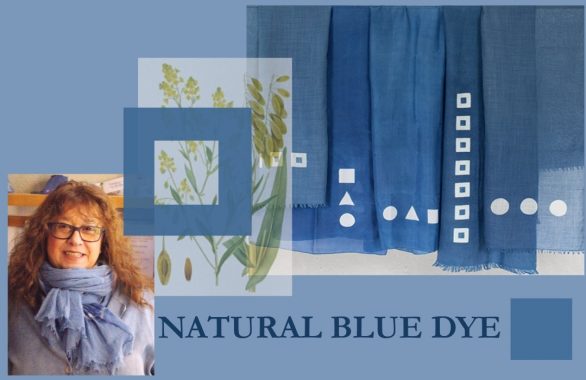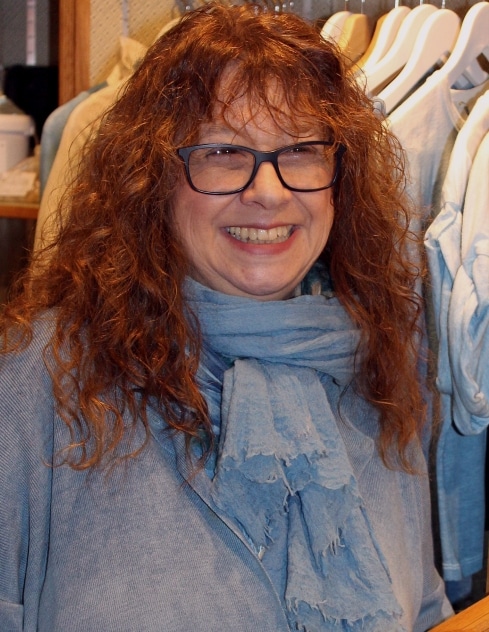
The Blue Message //
Messaggio nel Blu
Why does an Italian woman in the east German town of Erfurt dye special shades of blue with an ancient forgotten plant?
For Rosanna Minelli, this plant, which has been cultivated in Europe for more than 1000 years, has a fascinating history. The fact that the leaves of this plant, which is similar to rapeseed with its yellow flowers, shaped the blue fashion color for two centuries, and much more has become visible again through Rosanna's research and blue dyeing. How the blue pigment is created and how the dyeing process works is what she teaches in her dye workshops.
Rosanna and her blue vision
In her small shop on the famous ‘Krämerbrücke’ in Erfurt you can experience this blue world in many facets. Fine textiles, hand-dyed and printed, blue soaps and her blue pigment collection are only a small part of her product range. But the blue grape leaf border she restored around the ceiling and the painted portrait on the wall in the annex also shows that Rosanna has a wide range of expertise besides blue dyeing.
"In my small manufactory I give an insight into how, according to historical recipes, the cultivation of the woad and the production of the blue pigment is created. Also my hand dyeing of various fabrics that are made into unique textiles show these wonderful blue colors. I achieve the deep, darker blue shades by repeating the dyeing processesI complement some textiles with print patterns I have designed."
Rosanna uses the Japanese 'shibori' printing technique, which means using wooden forms to recess the area to be printed, to pattern her textiles. To produce her unique textile prints she uses old wooden printing forms from India and her own designs, which she makes with a master craftsman in Erfurt. Regional and handmade to the smallest detail – every textile is a true hand-crafted piece.
What will you learn at Rosanna's Plant Dyeing Workshops?
Also, at the dyeing workshops you will dive into this wonderful blue world. Not only will you learn the basics of the blue dye process with woad, but in a guided tour Rosanna will also teach you about the importance of this plant for the city of Erfurt and the surrounding villages in the Middle Ages. With the blue pigment produced by Rosanna from locally grown woad, the surprise effect comes right at the end. In the blue dye bath, the fabrics take on a yellow/green coloration. Only in contact with oxygen does the blue color develop. To obtain deeper shades of blue, the fabric must be repeatedly dipped in the green vat and left to air dry again.
Erfurt, Weimar, Bauhaus & the Woad Blue
As a homage to the 100th anniversary of BAUHAUS 1919-2019 and to one of her famous teachers Johannes Itten, Rosanna designs a 'BLUEHAUSe' collection. The blue of the woad with the printed squares give her scarves a timeless look.
"With the care I take in dyeing and printing, I also choose my materials. Some of my fabrics are woven in a small hand weaving mill in Sardinia. The yarn for the scarves is a mix of merino wool and Sardinian country sheep, fibers from the mohair goat, blended with cotton and silk."
This is not where the cultural journey ends for Rosanna. Here, too, she uses her woad blue pigment made from the locally grown plants from the countryside around Erfurt. With this she hands dyes her textiles also using her 'Made in Germany' wooden Shibori print forms.
Which blue actions has Rosanna already staged?
For the 2017 ‘Kramerbrücke’ Festival, Rosanna bathed the famous bridge of the medieval merchants in Erfurt with her banners in a blue light. As in the Middle Ages, blue panels of fabric hang between the houses. Printed with messages from important European poets and thinkers, translated into 8 different languages: Latin, Hebrew, French, Italian, Russian, Japanese, Arabic, English. An art installation that shows how important it is for Rosanna to show and to believe in the European ‘togetherness’. She also seeks exchanges with other woad interested people in Europe when it comes to her blue dyeing research and process. Natural dyeing with woad is experiencing a renaissance not only in Erfurt, but also in parts of France and her native Italy.
How does an italian art restorer get to Erfurt in Germany?
After studying art restauration in Genoa, Rosanna works on various projects in Switzerland, such as the cathedral in Lausanne, in Neuchâtel and in Basel. Then she moves to Bavaria and Thuringia in Germany The work on a mural in a famous villa in Erfurt Friedrich creates a new opportunity. She opens her first art supply shop with paints and restorers materials. There she organizes monthly art lectures and comes into contact with the blue of the plant ‘Isatis Tinctoria’ -the woad- through a local master craftsman.
The historical 'Blue Dye Business'
As a sought-after city guide for Italian, French and German guests in Erfurt and Thuringia, Rosanna repeatedly comes across the topic of woad cultivation and blue dyeing in her research on the medieval Hanseatic city of Erfurt in the eastern part of Germany.
“Commercial woad has been grown mainly in Thuringia since as early as the 9th century. The 'blue gold' from Erfurt was an important trade good in the medieval time and ensured the city's wealth. The city of Genoa has also historically grown with this blue color. The well-known name 'Jeans' means Genova. As early as the 16th century, thick fabrics were woven from cotton and dyed with woad blue for the sailors’ pants. It was only much later that Levis Strauss imported this cotton fabric from the cities of Genoa (jeans) and Denim in France to the USA and had it dyed there with the South American Indigofera Tinctoria (blue from India). But that was soon replaced by the artificially produced indigo pigment.”
The ‘Woad ball’ - a forgotten commodity
It is amazing that so little knowledge was saved from a dye plant that alone determines blue dyeing in Europe for more than 400 years. In the Middle Ages, the woad ball, which consists of dried and pressed woad leaves, was an important commodity and led to prosperity not only in Erfurt but also in other regions of Europe including Genoa, Rosanna's Italian hometown. In the 17th century, woad blue was replaced by the cheaper natural indigo from India. And at the end of the 19th century, the artificially produced indigo pigment was already being used. You can buy these woad balls in Rosanna's shop, transport them to your hometown and try dyeing them there. Or you can directly grow your own plants with the seeds of woad.
Art restorer and ‘blue dyer’ – what is the connection?
As a restorer, Rosanna knows the various artistic and technical techniques of using paint to restore a painting or a mural. Differences arise depending on the style epoch and the local conditions. When it comes to woad blue, she is not only interested in the theory, but also in the application. So Rosanna starts her first attempts at dyeing, researches further and finds a local woad farmer to produce her own pigments. An exciting blue journey also through Italy and France begins for her.
Rosanna and her blue knowledge
Over the years Rosanna builds a small but fine center of ‘blue dye’ excellence and knowledge in Erfurt. Because for her it is very important to revive and to investigate the 'old blue dyeing' process and the natural resources. Rosanna is fascinated by how environmental conditions influence the coloring power of the dried woad leaves. With her blue pigments, which she has been producing in recent years from the local harvest of a woad farmer, she documents the blue intensity depending on the weather conditions of those years. Depending on the growth phase in which dry and moist conditions happen, all of this influences the blue of the pigment and the dying shaded. Nice to think that the blue hues of Rosanna's textiles are vintage colors – unique each year.
The next blue step!
There is no standstill for Rosanna. She is always looking for new networks. In Ballenstedt, a small village in the countryside, the association 'heimatBEWEGEN' has opened a community center for creative people. Rosanna now dyes larger amounts of fabric in her blue colors. Another step to implement new bigger projects. Rosanna combines her Italian temperament and energy with her never ending idea. Now she also offers other natural plants which can produce other wonderful natural dyes. Not only the blue from woad, but also the yellow from dye chamomile and goldenrod or the red from madder root are now part of her dye workshops.
The blue color vision - and you?
Maybe the blue fever grabs you too, the opportunity to combine newly researched and old knowledge? The enthusiasm for this wonderful gift of nature that needs to be preserved and revitalized.
“I have been involved in blue dyeing for many years. Since my working hours are finite, I would like to put what I have built up in someone else's hands. I am looking for a successor over the next few years who will accompany me a part of the way, who wants to learn and help to shape the next blue step."
If you're interested in Rosanna’s project or want to participate at her dyeing workshop first, get in touch with Rosanna. She's happy to hear from you.

Name: Rosanna Minelli
She is: Restorer of wall and canvas paintings, natural dyer, 'Erfurter Blau' shop owner, freelance lecturer, city guide
She can be found in: Erfurt, the medieval Hanseatic city in Thuringia, East Germany, in her shop on the famous 'Krämerbrücke' the medivial merchants street
She likes: Having a coffee in the morning and starting the new day
Art with a capital K - that means: Art that can touch the soul, art that can give emotions and creative new impulses, no matter in which century it was created. From Pablo Picasso, Michelangelo Merisi da Caravaggio, Jackson Pollok, Jacopo da Pontormo, Leonardo da Vinci, Man Ray, and many others.
She admires:
- Virginia Wolf - British novelist and publisher (1882 -1941)
- Grazia Deledda - Italian writer and 1926 Nobel Prize winner for literature (1871 -1936)
- Marguerite Durat - French novelist, playwright, screenwriter and film director (1914 – 1996)
- Camille Claudel - French sculptor and painter (1864 -1943)
- Oriana Fallaci - italian journalist and writer (1929 – 2006)
Her WIASOLA tip:
"Always ask questions, seek the answers, and never be satisfied or think, 'I've accomplished, done, and sought enough.'
Her favorite art:
- Music: 'Stabat Mater' by Pergolesi
- Compositions by Arvo Pärt - The Estonian composer is considered one of the most important representatives of the New Simplicity
- Films: 'Bicycle Thieves' by Vittorio de Sica & 'Metropolis' by Fritz Lang
- Literature: "A Man" by Oriana Fallaci
Her 5 favorite museums:
der ‚Louvre‘
das ‚Centre Pompidou‘
die ‚Uffizien‘Pompeji
und viele, viele mehr!!
To be found under: